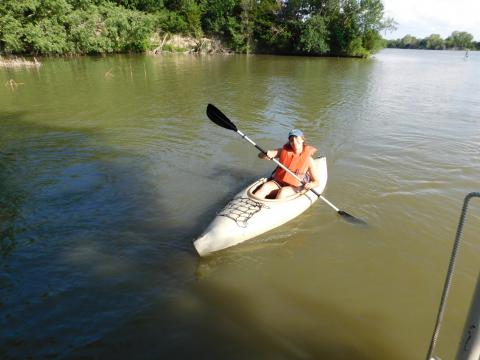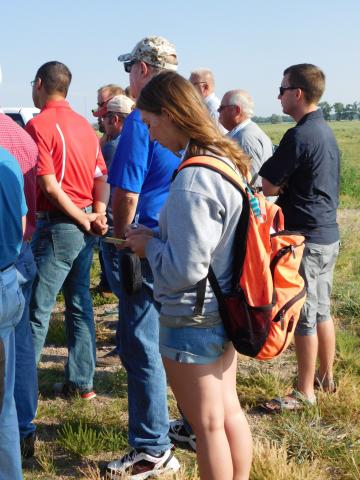Jasmine Mausbach, University of Nebraska-Lincoln
This year’s 46th Annual Water and Natural Resources Tour explored Nebraska’s central Platte River basin and the many uses and users associated with what is arguably Nebraska’s most important surface water resource.
The tour departed Holdrege Tuesday, June 27 at a brisk 8 a.m., kicking off with a talk from executive director, Jerry Kenny about the Platte River Recovery Implementation Project (PRRIP) water augmentation site near Overton. PRRIP is now in its 20th year as a major player in Nebraska water and environmental discussions on the Platte River, with its overall purpose being to aide habitat restoration efforts for four target species – the whooping crane, pallid sturgeon, least tern and piping plover. This specific site however, diverts water from the nearby Platte River, pumps it onto the land through cells, and creates a recharge area to maintain a lowland grassland/wetland for whooping crane nesting and migration. PRRIP achieves this by re-timing water, leasing water, or by working on ways to reduce water consumption near the Platte River.
Our second stop was at an organic farming operation near Smithfield where owner/operator Tom Schwarz explained how he grows peppers, tomatoes and other crops to make a signature salsa and sloppy joe mix. He also spent a good deal of time explaining what exactly an organic farm entails and the steps that have to be followed to be certified as “organic.” En route to our next destination at Johnson Lake, John Thorburn, general manager of the Tri-Basin Natural Resources District (NRD), spoke about the proposed Platte to Republican River Diversion Project. At the lake’s inlet structure, tour co-organizer Jeff Buettner of The Central Nebraska Public Power and Irrigation District (CNPPID) spoke about Turkey Creek in relation to the Platte to Republican River Diversion Project. The diversion project will involve installing a culvert under U.S. Highway 23 to divert flows from the CNPPID E-65 Canal to the east branch of Turkey Creek to maintain compliance with the three-state Republican River Compact.
In the afternoon at the Monsanto Water Utilization Learning Center near Gothenburg, our group of 60 was treated to lunch and a presentation about the goals and projects of Monsanto, who operates four of the targeted learning centers. The Gothenburg center focuses on water use, so after lunch, we took a tour of Monsanto’s extensive test plots for corn, wheat and soybeans.
Next up was a visit to Frito-Lay’s Gothenburg Corn Handling Facility, where all of the chip giant’s yellow and white corn west of the 100th meridian is handled for all of the various corn-based chips the company produces in the western United States. If you are eating a Frito-Lay corn chip anywhere between Iowa and California, the corn to produce that chip came through their storage facility at Gothenburg.
The day’s final stop was at CNPPID’s Gothenburg Control Center, where engineer Devin Brundage, the Gothenburg Division Manager, talked about the ins and outs of the operating systems for CNPPID’s hydroelectric and surface irrigation facilities along the Platte River.
Day two involved a drive to Nebraska Cooperative Republican Platte Enhancement (NCORPE) project’s well field, where manager Kyle Shepherd and Kent Miller explained the project’s goals. Out of 120 wells in the area supporting the project, 30 are used as augmentation wells to meet compliance issues associated with the Republican River compact. The next stop at the Nebraska Game and Parks Commission’s (NGPC) North Platte Fish Hatchery allowed us to learn how Nebraska stocks rivers and lakes in the state with certain fish and mussel species.
Lunch was served at the University of Nebraska-Lincoln’s West Central Research and Extension Center in North Platte, after visiting field research plots where the extension center is currently hosting a much talked-about farm management competition known as Testing Ag Performance Solutions, or TAPS. Our final destination for the day was the Gerald Gentleman Station (GGS), just south of Sutherland. Owned by Nebraska Public Power District, GGS is the largest single producer of electric power in Nebraska and also the state’s largest traditional, coal-fired generating plant. NPPD plant management also pointed out that it is consistently rated as the cleanest coal-fired plant in the nation. GGS uses water from the Sutherland canal to create steam that spins huge turbines, which generate electricity within the plant, releases the water from the plant into a cooling pond, and then releases that water back to the Sutherland Reservoir where it ultimately ends up in the Platte River to continue flowing east.
On the last day of the tour, our first stop was at Lake McConaughy’s Water Interpretive Center where the group learned about the area’s updated water management plan from NGPC’s Colby Johnson. We then split into two groups; with one touring the inflow point of Big Mac’s Kingsley Dam while the other toured the control center of the outflow point on the other side of the dam with Devin Brundage. After a quick lunch break at Ole’s Big Game Bar and Grill in downtown Paxton and a clothes change in Gothenburg, the last event of the tour was a kayak trip down CNPPID’s main supply canal, between Midway Lake and Galagher Canyon, near Cozad. Once a sufficient amount of sunscreen was applied, we left in our yellow and orange plastic kayaks, heading about five miles east to our end point at Gallagher Canyon Lake. There, a bus full of cold beverages awaited our return.
Overall, the tour provided many different outlooks on how water from the Platte River is used in Nebraska. From habitat restoration for whooping cranes to electricity generation at Gerald Gentleman Station, water from the Platte River Valley is used by more entities than I imagined, all with the desire to conserve and properly utilize this precious water resource so that Nebraskans can continue to benefit from it for generations to come.
Lastly, I want to give special recognition to the following groups who organize and sponsor the annual tour: Nebraska Water Center; the University of Nebraska-Lincoln’s Institute of Agriculture and Natural Resources; The Central Nebraska Public Power and Irrigation District; Nebraska Public Power District; and the Robert B. Daugherty Water for Food Global Institute at the University of Nebraska. Without these sponsors and their contributions, this year’s tour wouldn’t have been possible, and I wouldn’t have had the opportunity to learn about the many entities utilizing Platte River Valley water resources within the state.
Editor’s Note: Blogger Jasmine Mausbach is a University of Nebraska-Lincoln undergraduate student pursuing bachelor’s degrees in both environmental restoration and Spanish. Curious about all things water, Jasmine is now a three-year veteran of the annual Water and Natural Resources Tour, as well. This year’s tour was June 27-29 in Nebraska’s central Platte River basin. Each year, the tour examines local and regional water issues, including agricultural water use, water management, water quality and environmental impacts. Initiated by Nebraska Extension in the early 1970’s and nurtured for many years by the Nebraska Water Center, the tour is now in its 46th year.


